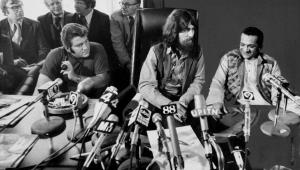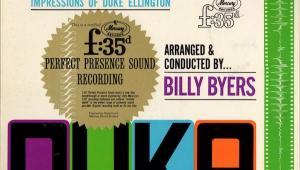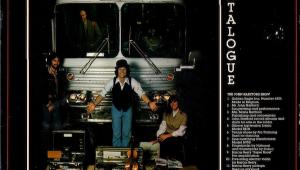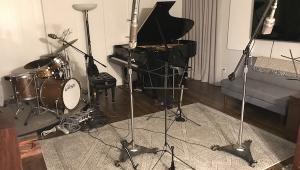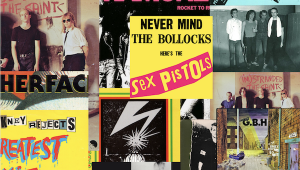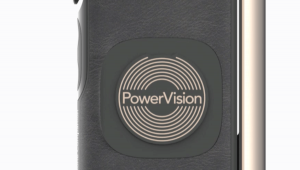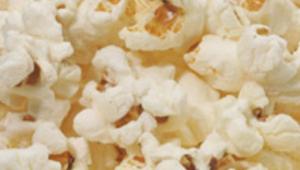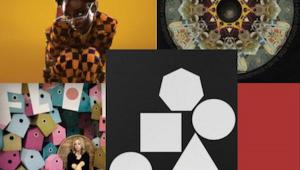I am a bit skeptical about the apparent revisionist history (probably from Paul, who is prone to such things) when it comes to these sessions. I've read a great deal about them, and I tend to agree with Ian MacDonald in Revolution of the Mind, where he shows it was the other way around: there was still camaraderie but more acrimony--witness how they were soon suing each other. But besides that, you talk in your video about what a great idea it would be to transfer the original mono tapes directly onto the vinyl, that Beatles fans would pay huge amounts for something like that. Are you being facetious? I thought you were involved in doing just that! Those editions are indeed out of print and fetching big bucks on eBay.
Beatles “End of Days” Produced Chaos and Creativity On the Long and Winding Road to Let It Be (factual corrections per K.Howlett email)
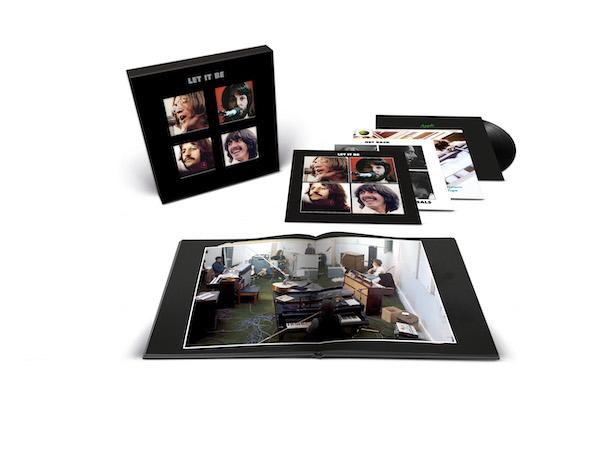
Never mind that the songs sometimes ended up being more individual than group efforts and that squabbling and disagreement led to acrimony as well as long time engineer Geoff Emerick exiting, producer George Martin going on holiday and even Ringo Starr walking out for a few weeks.
The resulting 30 song album, which took five months of work, released November 22nd 1968—the 5th anniversary of John F. Kennedy’s assassination— proved to be among the group’s most popular and it remains so.
A little more than two months later, workaholic Paul McCartney called the others back to the studio to work on the next Beatles album, one that all four Beatles decided should “get back” to the group’s original ethos of a band playing live—something it had not done in front of an audience since The Beatles played a 30 minute set in San Francisco’s Candlestick Park August, 29th 1966 before 25,000 screaming fans and let’s not forget 7000 empty seats.
The group decided to write and record a new set of tunes and document the rehearsals and recording sessions for a half hour TV documentary after which the group would perform live three times for invited fans, including plans for a proposed live TV concert. What could possibly go wrong with the “Get Back” project?
As it turned out, just about everything, caused in great part by a total change of production methodology, venue and difficult to resolve conflicts among and between the four now creatively territorial adults.
They chose to write all new material that would be filmed for a documentary, rehearse on an enormous soundstage and then record in a newly built studio using engineer Glyn Johns.
On January 30th, 1969 not long after rehearsals had begun The Beatles played an unannounced concert on the rooftop of the Apple Corp headquarters that was recorded for the documentary, performing nine takes of five songs, three of which would later be included on the Let It Be album, but meanwhile the group was also working on material that would result in the Abbey Road album.
The group released in April of 1969 the single “Get Back”. While the Apple sessions were still underway, Glyn Johns gave the group some acetates of mixes or early takes he'd made that the group rejected. The release of his later May 1969 compilation of a proposed Get Back album kept getting delayed because of the delayed release of the edited film footage. Even by March 1970, according to Kevin Howlett, "... it seemed that Glyn's compilation with some alterations – 'Teddy Boy' omitted and 'I Me Mine and 'Across The Universe' added – was going to be released. Phil Spector was brought in at the end of March 1970 and that's when Glyn's compilation was rejected – although not by Paul, who didn't know what Spector was doing". Meanwhile back in May the foursome went to work on Abbey Road, released September, 1969.
Most of this activity took place “under the radar” especially in America, so that in the fall of 1969 when Abbey Road was released most fans other than the hardcore followers figured that was the group’s intended next release after The Beatles.
Abbey Road proved to be among the group’s most popular and acclaimed records and remains so. By then the group had, for all intents and purposes broken up.
As the cataclysmic decade came to a close, rumors of a Beatles break-up surfaced and soon thereafter “the dream is over” became a reality. The group that had become a linch pin in the lives of a generation was no longer. The decade that seemed to climax with Woodstock and then Abbey Road ended with a depressing thud when it became clear that the “Fab Four” were no more.
Meanwhile, work continued to complete the Let It Be album, which included studio recordings produced at Apple headquarters, engineered by Glyn Johns interspersed with live rooftop songs. While the goal was an album of recorded live tracks with no overdubs, that didn’t happen and what did happen is a long, complicated story sorted out with great efficiency in the outstanding annotation included in both of the recently released digital and vinyl disc Let It Be sets.
By the time the final Beatles album was released in May of 1970 the young generation that had grown up with The Beatles, knew that the group had broken up and the Let It Be album, a mashup of studio and “on the roof” live recordings that had been Phil Spectorized with overdubbed strings and choir on three tracks ("The Long and Winding Road", "Across the Universe" and "I Me Mine", omitting “Don’t Let Me Down”, which had been the “B” side of the “Get Back” single (George Martin wrote and produced the much simpler arrangement added to the song "Let It Be") seemed like an “cash grab” afterthought (though that term had yet to be invented). The unappealing cover art, with each Beatle in his own box, especially after the whimsical Abbey Road cover didn’t help. According to Howlett, the Glyn Johns Get Back was slated for release until Spector was brought onto the project.
Though it was ready for release earlier, Let It Be wasn’t until May of 1970 because it conflicted with the release of McCartney’s eponymous solo debut. For his part, McCartney was so upset with what Spector had done to “The Long and Winding Road” that he sent a sort of cease and desist letter to Allen Klein warning him to never again do such a thing and years later to organize the 2003 Let It Be Naked remix that stripped away all that Spector had added. Whew!
The Let It Be Deluxe Vinyl and CD Box Sets
(There also is a "special" 2CD 26 track edition and a "standard" 1 CD and single LP vinyl edition, but I think AnalogPlanet readers will either want nothing or everything).
Michael Lindsay-Hogg, who, having produced, directed and edited a series of successful Beatles promotional films and videos, was hired to direct and produce the “Let It Be” movie (his name was lampooned in “Spinal Tap” becoming Sir Denis Eton-Hogg president of Polymer Records). His final cut documented an acrimonious, unpleasant environment that didn’t exactly add luster to the project.
If the producers, archivists, mixers and annotators of this project had a mission, it was to prove beyond any doubt that while The Beatles’ “End of Days” was turbulent, chaotic and occasionally acrimonious, the foursome were still fab following the 1968 release of The Beatles and their time together creating Abbey Road and Let It Be was both incredibly productive and especially filled with great music-making and camaraderie.
Their job was made all the more easier because of both the film footage (that director Peter Jackson has assembled for a new documentary soon to debut on the Disney Plus streaming service) and the fact that the film crew’s two Nagra mono production tape recorder was constantly running throughout the Apple sessions, rehearsals and jams.
Annotator Kevin Howlett was tasked with going through many hours of tapes and then assembling a coherent running order to which was added a selection of songs and musical experimentation recorded multitrack by Glyn Johns and mixed recently by Giles Martin for this compilation. The results can be heard on the double LP Get Back Apple Sessions, Rehearsals and Apple Jams, which document an exciting collaboration as the guys work through material for both Abbey Road and what became Let It Be.
Those discs and the book alone are worth the price of admission, but also included (finally) is an authorized version of bootlegged and very raw Get Back album that does include a version of “Don’t Let Me Down” and “Teddy Boy”, the latter included on McCartney’s eponymous solo debut album. Why Johns put “Let It Be” back to back with “The Long and Winding Road”, which in my opinion makes little compilation sense, is not explained in the annotation, not that it really matters.
Also included is a 45rpm 4 song EP containing a previously unreleased Glyn Johns 1970 mix of “Across the Universe” and a similar one of “I Me Mine”, a new mix of the original “Don’t Let Me Down” single and one of the original single version of “Let It Be”. That’s the vinyl package.
The digital version includes the same book in a slightly smaller format (and with a non-laminated cover) and a fold open insert containing 5 CDs and a Blu-ray disc of the same material including the 4 above mentioned songs on one CD. Yes, it’s a waste of "valuable" polycarbonate, but it’s the only way to correctly present the contents. The Blu-ray includes a Dolby Atmos 48kHz/24 bit DTS-HD Master Audio 5.1 mix, and a 96/24 PCM stereo mix, though as with previous Beatles packages you can’t download the 96/24 PCM stereo mix from the disc to your computer to have on your stereo system’s music server, which to me is inexplicable, but whatever.
Overall I think this is among the most successful stereo mixes of the entire series, in part because there was less (if any) “moving around” and/or “fixing” to do. The recording was originally to 8 tracks and there was minimal overdubbing, which was the original intent. As with the previous mixes, the timbral balance is midrange-rich, bottom end strong and top end “reticent” compared to original pressings (I like more “snap” to snares and “sizzle” to cymbals as can be found on the original U.K. pressing) but the minor “in the pocket” balance updates produce insightful and enjoyable improvements on just about every tune.
There’s also a bit more compression than I like so when you put all of that together on the opener “Two of Us” Ringo’s 1/8th note snare hits that lead into the bridge “You and I have memories….” lacks the expected “snap” and the way he sneaks up the intensity of each of the 8 hits, which I’ve always found fascinating are both missing in action (this was confirmed by a well known musician friend of mine).
Miles Showell’s ½ speed mastering works really well on this set and unless you really don’t like this album, you’ll surely appreciate the mixes and mastering on the “mature” tunes: “Across the Universe”, “Let It Be” and “The Long and Winding Road”. Nothing can make “Dig It” palatable but it’s short and it’s a “period piece”.
Finally, the copy I got was sealed and not “special” though it was in that every 180 record in the set was perfectly pressed: flat, well-centered and quiet.
The YouTube video I made embedded below had a few comments that said, “You can’t polish a turd”. This record may not be the jewel in the Beatles catalog but a turd it’s not! If it’s a piece of anything, it would be a piece of history every Beatle fan would enjoy learning about by reading the book and listening to the Apple Sessions, Jams and Rehearsal records in preparation for Peter Jackson’s movie. If this is the end of the Beatles reissue remix road, it’s a fitting place to stop, though as I say in the video, I’d sure like to hear AAA reissues of the catalog done like the mono box set. Wouldn’t you?
We can't put "music" and "sound" dials into features stories but I'd give this remix a 7 for music and an 8 sound.
- Log in or register to post comments


Now that was informative! The Everly Brothers, I do collect and will be looking for the 4 you showed. I noticed you have a charlie brown christmas lp in the back round, always wondered which one, and if I should, pick one up for the Holidays. As always, you did a great job on a new one that should be in a Beatles collectors collection.

"you can’t download the 96/24 PCM stereo mix from the disc to your computer"
Yes, you can - With specialized software for ripping BR discs.
I've done it on the previous BR releases and also on All Things Must Pass.
You need a BR disc player and 2 pieces of software:
DVD AudioExtractor
and
Passkey for Blu-Ray.
Here's a link to an explanation of how to do it. It's easy once you have the SW.


It just makes no sense to me to remix an album yet use Phil Spector's mix as a guide. Why not just master the original mix the best that one can and let it be?! I have the same sentiments in regards to the Let it Be and Don't Let me Down single remixes. It's ridiculous.
As for the rehearsal sessions and jams, that's all good and worthy of being issued, however some of my favorite ones aren't included in the set.
Lastly #1, regarding the Get Back film. Macca and company seem to be rewriting history which is BS. The real history is fine just as the original mixes were in my opinion.
-Stoned Beatles

Saw an interview with Giles Martin where he said they are going to review the tapes and decide if they can do something worthwhile with them also.
He said they will only do it if it makes sense sonically; that they won't do it just as a money grab.

...should be next. These songs were recorded in the Sgt. Pepper through white album eras, with the exception of the song Yellow Submarine, that can be improved. Penny Lane and Strawberry Fields Forever have already been released, but there's still the rest of the songs including the singles All You Need Is Love, Baby You're a Rich Man, Hello Goodbye, You Know My Name (Look Up the Number), Lady Madonna, and The Inner Light.

I'd love to see an audiophile quality pressing of the original Yellow Submarine LP, complete with George Martin's underscore. I played that a lot when I was a kid.

MMT-
Since it's not really an album (only in the States) in the Beatles'original catalog. Penny Lane and Strawberry Fields have already been remixed and re-released as part of the Sgt Pepper remix (as they were originally from those sessions). Don't think they would have done that if they were planning to remix the album and re-release it.
YS - all the Beatles songs in the original soundtrack album were remixed years ago and even given surround versions. Just look for the YS "soundtrak". It was the first remix of Beatles material. No reason to do it again, especially as it's an afterthought in the catalog.

...is not the same as what Giles Martin has been doing since 2017. Aside from the soundtracks, the Yellow Submarine Songtrack from 1999 was a remix of the existing 4 or 8 track tapes for each song, not going back to the original master takes before any mixdown was done to free more tracks for more recording.

"The Beatles: Get Back" is unfortunately not on Apple TV+, but rather on Disney Plus. Makes it difficult for those of us without young kids. I have a year of Apple TV+, which came free with my recent iPhone upgrade. Not inclined to pay for Disney, though I do want to see this.

and then cancel.
Doesn't cost much.

Difficult? It's like $7 for a month. & BTW, Disney Plus has a ton of quality programming that isn't necessarily geared toward kids.

Are you saying that just getting single LP version should be avoided?
Even if had $200.00 to spend on an album (and thought it was a good idea) I am not inclined to think that all the extra stuff is worth spending $170.00 on. I might listen to the extra stuff once or twice but it is the original stuff i want.
I do not have any copy of this album and i want one, Should i get this remix or find an original pressing?, and of so what is the best pressing to seek out?
I want nothing to do with digital files or CD's. The only music i consume is fed to me by my turntable.
Thanks for all the info you provide on the world of vinyl.

Buy the one album and listen to the rest on streaming.

Bought just the new LP, a vast improvement over my near pristine original US pressing. Like a previous reader, I miss Michael’s usual rating dials. I would give the single LP a 7 and an 8.
Apropos earlier comment, Ken Micallef has a nice video on Charlie Brown Christmas.

What scores would you give what scores would you give the original US stereo LP? Curious.


UK preferred. Pre-1986 because from 86 on, the vinyl was pressed from digital/CD masters :( Avoid the usual audiophool stuff like Mo-Fi, Japanese, 1/2 wit/digital remasters etc.
If you want all the albums in their best form - a pre-1986 "blue box" collection of all the original albums plus the Rarities compilation. That's all the Beatles vinyl you'll ever need !

Was the box sealed, or both the box and the individual LPs?
I was surprised at how toned-down the strings and voices were in, for example, "Across the Universe." I need to compare the original and this one side by side, but, on balance, I found the background vocals in particular to be less intrusive on this mix. That's definitely a revision, though.
In theory, the alternate takes and other additional material have some value, but I never listen to them after the first play.

I still have the original Get Back book that came with the 1970 LP. Some of the first few pages are slightly wrinkled, and the binding glue was never adequate, but all the pages are together. The pages don't seem to have yellowed, either. Some slight creases on the cover. Otherwise, it's in pretty good shape.
The text of this original book is more like various transcripts of some of the film dialog. No commentary or appraisal of the goings-on by anyone outside the group and production crew. In other words, no historical context at all.
Should I sell this original book for a good price, and get the new box set, with the nice new book?
What would you consider a good selling price, if I were to let it go?

are going for something in the $250 to $300 range on Discogs.
The books all seem to have the same problem with the pages coming apart.
Link: https://www.discogs.com/sell/release/1088126

...in 2004 for just $33. Canadians apparently bought the Let It Be box in 1970 and don't mind separating the book from the LP. You may find another book for a reasonable price.

Even my wife sits and listens,and she NEVER does that! I believe the sound quality is more 8/9 on Michel's dials ,it's live! Mesmerizing,a vast improvement over the later Abbey Road sessions.those sound more entropic. Cheers,Chet

First I have to say I love your video, I think it’s because it mirrors my opinion of the fab 4, though l’m a little younger than you. I was 10 when they appeared on Ed Sullivan. I think Let It Be was not received well by critics and some fans because they were always moving forward musically and technically. So when it was delayed and then released after Abbey Road it was like a step backwards, plus the shine was a little off the rose. Led Zeppelin had replaced them as the top band in England. The first two Led Zep albums were two of the greatest albums ever made, but l’d still chose Let It Be 3 out of 4 times to listen to.
Thanks for another great video, M1chael

Michael, I do plan to get this set after watching your video. Well done, and the set looks impressive.
However, I wasn't planning to buy it. I have a 3rd press UK (the first pressing after the two that came with the book). It's SO far superior than my original US red Apple label. It's close to demo quality on some of the songs. It's so good, I wasn't thinking that I needed another pressing.
But the book as well as the other extra material has sold me on it.
By the way, it's far from The Beatles' best album, but, for me, it's like saying Beethoven's First Symphony is not his best.

All the CD tracks can be streamed/downloaded in 96/24 from Qobuz.

this set very much. In my opinion, the sonics are terrific. I don't have an original British pressing, but I'm looking for a good copy at a reasonable price. Of all of the repressings, this is easily my favorite. And the book is terrific. I can't wait until Mark Lewishon gets to this era in his incredible and incredibly detailed huge tome.
As an aside, I'm one of the rare people who enjoys what Spector did with Long and Winding Road.

Jenn...Good to meet one of the "rare people" who like the Spector production on LIB...Not sure that sentiment is very rare though, as with many in my era (I'm 65) I grew up with the Spector version and like it, it's burned in my aural DNA. I bought the new book this week and will probably buy the single Giles Martin LP just for comparison.

Michael, I very much enjoyed your video on the history of LIB but a rating of 7 for the music? Yes, if you compare it to other Beatles music. If you compare it to music being produced today, I would say 11!

Boxes take up $$$ and precious shelf space, and as others here have remarked, the extra material is rarely worth more than a single listen.

https://www.youtube.com/watch?v=dRbRSqRg4MI This Beatles Channel says only in the Japan version do we get the TRUE 1969 mix. All the other European edition/American/Australian. But then "The World Version" might be the better sounding over the Japan version!:-) Oh well

They could/should have included the roof top sessions
Maybe that’s a Jackson Blu Rah special feature

than the original LPs (regardless of which pressing you have) and has a slight treble lift that makes the cymbals a bit too pronounced.
To my ears, the remaster of the 2009 stereo Beatles box is the better sounding digital version so far.
Loved hearing the Get Back mixes though!

Glad I watched your video. I was initially happy with the 2cd SHM version that I purchased. Thinking that was all I wanted of Let It Be. BUT..after the review and listening to the CD I bit the bullet and got the box set...so glad I did....it is excellent and I feel that this is the best remix of the bunch. Sgt Peppers vocals have an odd sound to them and where did the beautiful bass guitar go...same with the White Album...in the new mix you can hear obvious vocal imperfections that are mixed nicely in the original mix as well as the loss of that awesome clear and beautiful bass tone.

I don’t know where else to address this. If you can sit through part 1 & 2 of the Get Back documentary, part 3 will treat you to the best live performance of any entertainers I’ve ever seen. I know that’s quite a statement. The original Let it Be film didn’t do justice to that rooftop performance. On another note, owners of the Let it Be deluxe vinyl boxset are complaining on SH forum of distortion on the final two tracks of those albums. Have you experienced this problem Mikey, would like to know if it’s a system or vinyl problem.
Thanks M1chael







